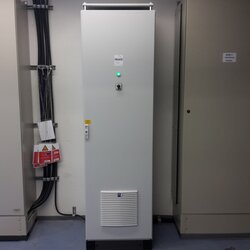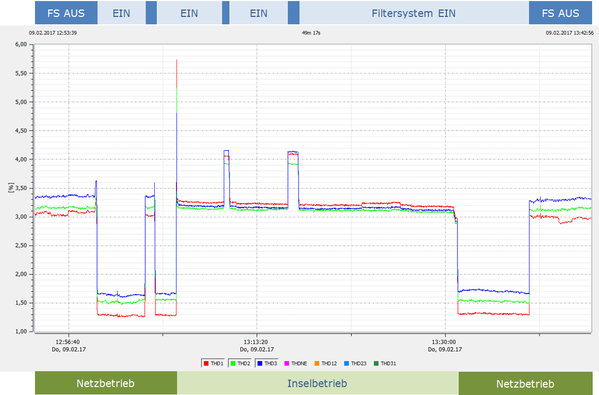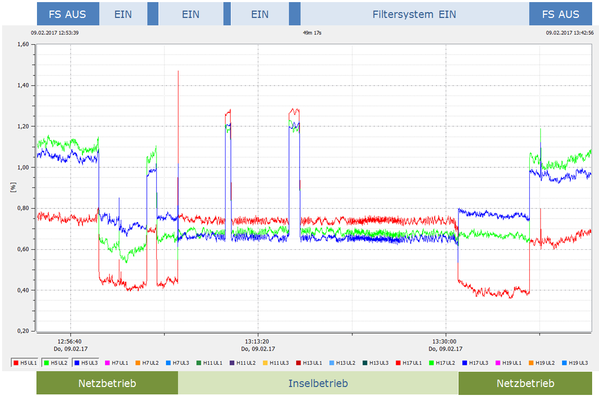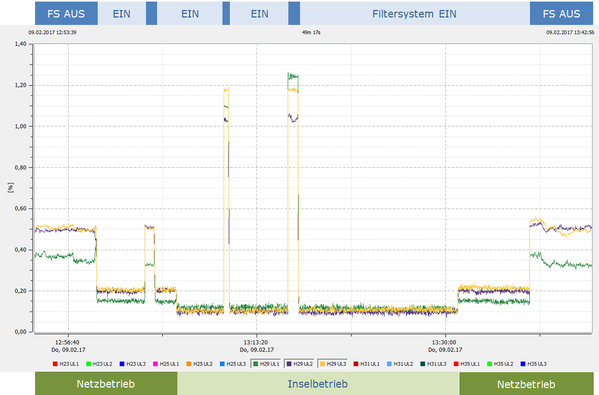Voltage-controlled active filter gives standby generator power quality
Nowadays, nearly all the consumers connected to the electricity supply network constitute non-linear loads. Their non-sinusoidal current draw distorts the supply network voltage and thus generates harmonics. This results in overloading of the connected devices and installations, which can disrupt the infrastructure of a company even to the point of jeopardizing operational reliability. Passive or active filter systems provide a remedy for this situation.
Difficulties arise with vital infrastructure systems in which network stability must always be ensured, not only when running on the normal power supply but also when powered by standby generators. Such critical infrastructure facilities have a high societal relevance and merit special safeguards. Examples include IT and telecommunications systems, electrical distribution networks and water supplies, medical and emergency services, and financial systems, to name but a few.
A public service broadcaster installed new transmitters when upgrading from the DVB-T to the DVB-T2 HD standard, which promised to provide more programmes with a much improved picture quality. As public service broadcasting is also considered a vital infrastructure, the transmission equipment must be able to broadcast at all times without interruption. In addition to working from the normal power supply, the system must also function correctly when an emergency generator is providing the power. FRAKO was entrusted with the analysis of power quality measurements made during operation with both external utility power and the standby generator, in order to identify any problems with harmonics or resonant ranges.
Results: The new transmitter system with a total rating of 150 kW is not a particularly powerful consumer. Its power factor (cos phi, inductive) is better than 0.95 and therefore no power factor correction is needed. All harmonic voltages up to the 50th, and their geometric sum THDv, were within the limits called for by Class 2 of the standard EN 61000-2-4 when the installation was running on external utility power. However, when it operated with power from the standby generator, high harmonic levels above the 25th, i.e. well above 1 kHz, were identified. These resulted from points of resonance around the 29th harmonic, the measurements revealing an abrupt rise in higher-order harmonics.
Network problems with harmonics when a standby generator is used
The points of resonance are caused by the capacitances in the transmitter systems that are not detuned. They give rise to network resonance at about 1450 Hz, and should therefore by compensated for with a filter. However, the resonant frequency varies greatly, being dependent on the short-circuit power of the complete installation. When operating with power from the external utility, its short-circuit power is high, the resonant frequency being over 3 kHz, but when powered by a standby generator the short-circuit power is much lower, the resonant frequency falling to only 1.5 kHz.
When the filter system is selected, the primary objective is to obtain undisrupted operation when running either on external power or with the standby generator. In addition, the harmonics, which as a rule are audible, must not be broadcast by the transmitter system.
Only voltage-controlled active filters are suitable
Passive filter systems act inductively at frequencies above their tuning frequency, displaying a low impedance to the harmonics and thus effectively absorbing them selectively. Their disadvantage is that they are only designed for a certain frequency range, and they create an additional fundamental frequency reactive power, which in this case would have resulted in a capacitive power factor. This, however, was not the only reason they were unsuitable for the application—the harmonics spectrum when operating on generator power is also vastly different.
Active filter systems provide a compensating current in phase opposition to neutralize the harmonics. They can automatically adapt to the frequencies to be compensated. A distinction is made between current-controlled and voltage-controlled active filters. The former measure the load current and use Fourier analysis to compute the required compensating current in phase opposition. They can neutralize various orders of harmonics simultaneously while dynamically correcting reactive power. Voltage-controlled filters can be impedance-regulated, i.e. not only do they neutralize the harmonics, they also actively suppress resonance. As no current transformers are necessary, these systems work significantly faster than current-controlled filters.
In the case of the transmitter application, a voltage-controlled active filter was the optimum solution. Had a current-controlled active filter been used, there could have been instability between the filter's current regulation function and the control of the standby generator when this was operating.
The solution: OSFS high-speed active filter

The broadcaster was supplied with an OSFS 100-400-3-V voltage-controlled active filter by FRAKO. This 3-wire device with a nominal power rating of 70 kVA can compensate harmonics up to the 100th, i.e. up to 5 kHz, either the entire spectrum being neutralized or only selected frequencies. In addition, resonance is extensively dampened. A response time of under 20 µs makes the filter especially suitable for rapid and substantial load changes. This active filter system does not require current transformers, which in this case simplified the electrical installation.
The OSFS-V meets the specified requirements when the system is operating on external power or with the standby generator, now considerably reducing the impact on the power supply network. The levels of all the previously critical higher harmonics have been significantly reduced. This is particularly evident on standby power, since far less generator noise can be heard. Additionally, in both operating modes the typical 5th and 7th harmonics from the frequency converter have been reduced to uncritical levels below 1%.



